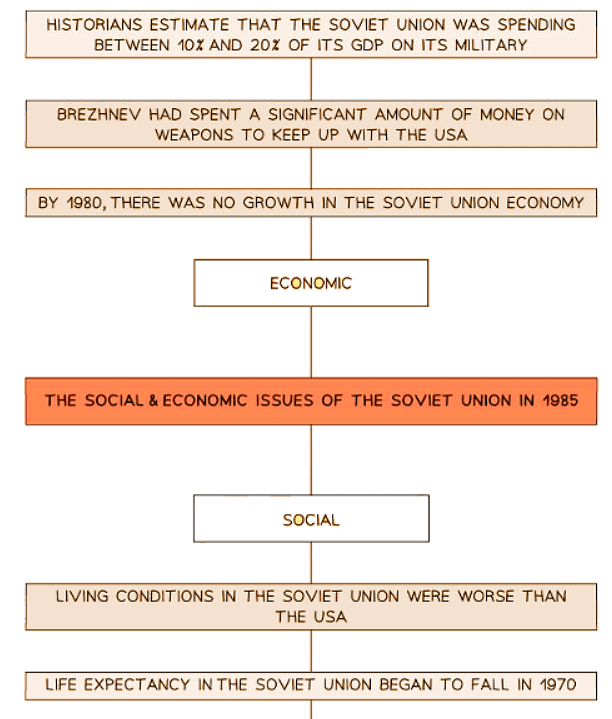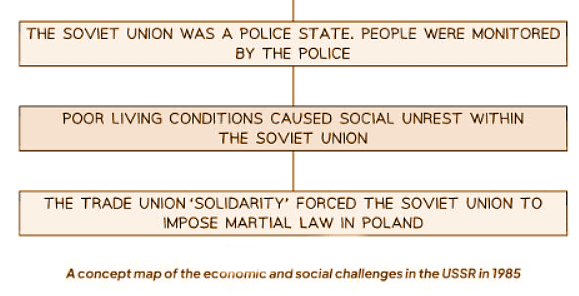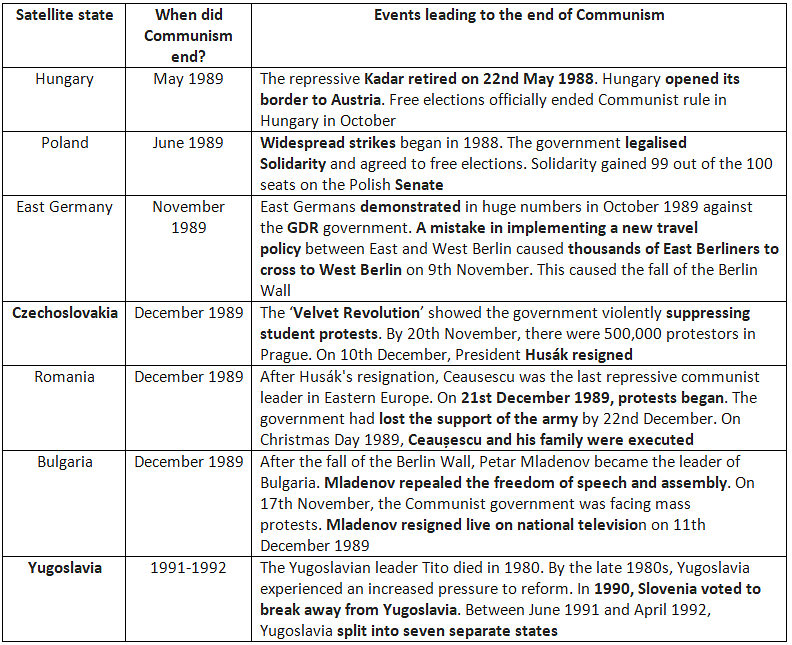Year 11 Exam > Year 11 Notes > History for GCSE/IGCSE > Gorbachev & the Collapse of Soviet Control over Eastern Europe
Gorbachev & the Collapse of Soviet Control over Eastern Europe | History for GCSE/IGCSE - Year 11 PDF Download
Who was Mikhail Gorbachev?

- Leonid Brezhnev passed away on November 10, 1982, due to a heart attack while still in office.
- Following Brezhnev's death, the Soviet Union experienced a period of unstable leadership from 1982 to 1985.
- Brezhnev's successor, Yuri Andropov, died in 1984, further exacerbating the leadership vacuum.
- Andropov was succeeded by Konstantin Chernenko, who also passed away in 1985, adding to the turmoil.
- In March 1985, the Central Committee nominated Mikhail Gorbachev as the new leader of the USSR.
- Gorbachev had ascended through the ranks of the Communist Party, holding significant positions such as party secretary of agriculture.
- As the leader of the Soviet Union, Gorbachev advocated for the implementation of democratic reforms to address the country's challenges.
Why was There a Need for 'New Thinking'?
- By 1985, the USSR faced serious economic and social challenges.


- When Gorbachev assumed leadership, the USSR was on the brink of economic collapse. He believed that reform would:
- Save the Communist economy.
- Increase the well-being of citizens in the USSR and its satellite states.
Perestroika - 'Restructuring'
- Gorbachev initiated perestroika to overhaul the economy, signifying 'restructuring' in Russian.
- Key facets of perestroika encompassed:
- Decrease in military expenditures
- Downsizing of the Red Army
- Cessation of the arms race with the USA
- Incorporation of more capitalist features into the economy
- Permission for the formation of small, privately-owned enterprises
- Elimination of constraints on foreign trade, enabling businesses to engage in freer trade globally
- Diminished government regulation over businesses
Glasnost - 'Openness'
- Glasnost, which translates to 'openness' in Russian, was a pivotal aspect of Gorbachev's reforms.
- Under glasnost, there were fewer restrictions on censorship and freedom of speech in the USSR.
- Citizens gained the ability to openly discuss and critique the government without as much fear of reprisal.
- Soviet control over the media was notably reduced during this period.
- The USSR also began to acknowledge and take responsibility for past repressive actions.
- For instance, the Soviet government publicly recognized events like the Hungarian Uprising and the Prague Spring as peaceful attempts at reform.
- Opposition to the government was increasingly tolerated, and discussions about potential elections began in 1988.
- There was a firm commitment to combatting corruption within the Soviet government.
- These reforms led to improved relations with the West, as evidenced by Gorbachev's participation in summits with President Reagan from 1985 to 1989.
- Gorbachev's address at the United Nations in 1988 reinforced the USSR's dedication to reform and marked the establishment of a robust diplomatic relationship between Gorbachev and Reagan.
The End of Communism in Eastern Europe

The End of the USSR
- Changes in Eastern Europe had a significant impact on the Warsaw Pact, leading to the loss of Soviet influence over the region. This culminated in the cessation of military collaboration by the USSR in early 1990 and the formal dissolution of the Warsaw Pact in July 1991.
- The 'Gang of Eight' attempted a coup against Gorbachev in August 1991, aiming to take full control of the USSR and impose a state of emergency. However, the coup failed due to insufficient backing, vocal opposition from key figures like Boris Yeltsin, and Gorbachev's resilience in continuing to lead the country. This episode significantly damaged Gorbachev's reputation among the Soviet populace.
- Following these developments, 12 constituent states of the USSR came together to form the Commonwealth of Independent States, marking the conclusion of Gorbachev's leadership in the USSR. Subsequently, on December 25, 1991, Gorbachev stepped down from his role as the General Secretary of the USSR.
Actions of the USA
- The United States played a significant role in the downfall of Communism in Eastern Europe.
- President Reagan of the United States adopted a firm stance against the Soviet Union.
- The Reagan Doctrine provided assistance to anti-Communist factions striving to topple Communist regimes.
- On the 8th of March 1983, Reagan delivered a speech denouncing the USSR as an 'evil empire.'
- He introduced the Strategic Defense Initiative (SDI) as a defensive measure.
- The USA pressured the USSR into economic strain by overspending on defense expenditures.
- Reagan, observing Gorbachev's reform efforts, sought amicable relations with the USSR.
- Summit meetings held between 1985 and 1989 contributed to the enhancement of US-USSR relations.
- In December 1987, both superpowers consented to the Intermediate-Range Nuclear Force (INF) treaty, aiming to eliminate all land-based missiles within the range of 500km to 5,500km.
Question for Gorbachev & the Collapse of Soviet Control over Eastern EuropeTry yourself: What was the main goal of Gorbachev's economic reform, perestroika?View Solution
Events in the USSR during the 1980s
- During the 1980s, the economy of the USSR began to face severe challenges and showed signs of failure, impacting the country's overall stability.
- The USSR found it increasingly difficult to sustain its satellite states economically, leading to strains within its sphere of influence.
- A significant event was the Soviet invasion of Afghanistan in 1979, which proved to be a costly and unsuccessful military campaign. The guerrilla warfare tactics employed by the Mujahideen posed a formidable challenge to the Soviet Red Army.
- Gorbachev's decision to sign a treaty to end the Afghan conflict in 1988 marked a shift in Soviet foreign policy.
- The political landscape in the USSR started undergoing transformations as Gorbachev's reforms encouraged dissent against Communist regimes in various satellite countries.
- Calls for independence grew louder within the USSR, with regions like Ukraine and Lithuania demanding autonomy from Moscow's control.
- Within the USSR, there were differing viewpoints on the country's priorities, with some advocating for a focus on strengthening Russia over other Eastern European states.
- Boris Yeltsin emerged as a prominent figure, becoming the President of the Soviet Republic of Russia in May 1990 and eventually exerting significant influence in Russian politics by the end of the decade.
The document Gorbachev & the Collapse of Soviet Control over Eastern Europe | History for GCSE/IGCSE - Year 11 is a part of the Year 11 Course History for GCSE/IGCSE.
All you need of Year 11 at this link: Year 11
|
81 videos|86 docs|18 tests
|
FAQs on Gorbachev & the Collapse of Soviet Control over Eastern Europe - History for GCSE/IGCSE - Year 11
| 1. Who was Mikhail Gorbachev? |  |
Ans. Mikhail Gorbachev was the leader of the Soviet Union from 1985 to 1991. He is known for his policies of perestroika (restructuring) and glasnost (openness) which ultimately led to the end of communism in Eastern Europe.
| 2. Why was There a Need for 'New Thinking'? |  |
Ans. There was a need for 'New Thinking' in the Soviet Union because the country was facing economic stagnation, political repression, and social unrest. Gorbachev believed that reform was necessary to modernize the Soviet system.
| 3. What were Perestroika and Glasnost? |  |
Ans. Perestroika was the policy of restructuring the Soviet economy and political system to make it more efficient and responsive to the people's needs. Glasnost was the policy of openness, allowing for more freedom of speech and transparency in government.
| 4. How did Gorbachev's policies lead to the end of communism in Eastern Europe? |  |
Ans. Gorbachev's policies of perestroika and glasnost sparked a wave of reforms and revolutions in Eastern Europe, leading to the collapse of communist governments in countries like Poland, Hungary, and East Germany.
| 5. What were some key events in the USSR during the 1980s that led to the collapse of Soviet control over Eastern Europe? |  |
Ans. Some key events in the USSR during the 1980s include the Chernobyl nuclear disaster, economic struggles, and growing unrest among the Soviet republics. These factors weakened the Soviet Union's grip on Eastern Europe and contributed to the eventual collapse of communism in the region.

|
Explore Courses for Year 11 exam
|

|
Signup for Free!
Signup to see your scores go up within 7 days! Learn & Practice with 1000+ FREE Notes, Videos & Tests.
Related Searches

















